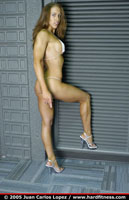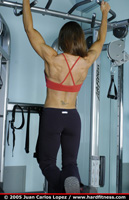 | ||||||||||||||||||||||||||||||||
| | |
|
| |
| | |
|||||||||||||||||||||||||
| |
||||||||||||||||||||||||||||||||
| |
|
|||||||||||||||||||||||||||||||
|
Back Training by Alissa Carpio
Whether you're a current competitor, aspiring competitor, or fan of the sport, you probably know the importance of having a well-developed back. In physique competition, it’s obvious that the back is one of the most important body parts in creating the perfect physique. Since my interest in competing over 5 years ago, I have been in awe at the many awesome backs I've seen on the fitness and figure stage. When I first started training for competition, my back was a weakness of mine, for several reasons. First, I didn't know how to properly hold my shoulders and feel the right muscles working. Second, I was doing a lot of the wrong exercises. And third, while I thought I was training hard, I wasn't training as smart as I could have, and my program design wasn't optimizing the growth in width and thickness that I was looking for and needing to place better in competition.
I put a lot of time and research into back training after receiving judges’ feedback that I needed to increase my back width. I started with most of the typical exercises – wide grip assisted pull-ups, lat pulldowns, barbell rows, dumbbell and hammer rows. I saw minor improvements, but not to the extent I needed to compete strongly at the national level. I began “power building” – training as a bodybuilder while also including power lifting exercises. Traditional deadlifts helped me make some more gains in thickness, but I was still lacking. Finally, I knew what I had to do but had been putting off for some time – pull-ups! I began every back workout with 3 sets of wide-grip pull-ups, doing as many as I could (always grabbing a spotter) until eventually I could perform 3 sets of 8-12 on my own. My next strategy was to increase my training volume to bring up my weak body part, so I added in more back work on a second day later in the week. My training scheme included heavy lifting and high volume, and my body responded extremely well. I added 8 lbs. of muscle overall to my frame while dieting for Nationals in 2005, and my lat width and thickness were more complete than they ever had been. Part of being a successful competitor and continually making noticeable improvements is to keep researching, educating, and trying new training methods. If you stick to the same thing or just inside the box thinking, you are limiting yourself and your potential for growth and development. I know my training program won’t work for everyone, but I want it to be an example that it takes more than just hard work to improve. It takes intelligence, education, and an open mind. And above all, it takes dedication! The following back routine will target every major muscle in the upper back and will include focus on both width and thickness. Sticking to basic, core lifts will help you gain strength and size faster than any machine ever will. Don't be afraid to lift heavy and hard, but make sure you know what you’re doing and you can feel the muscles working in every exercise. Train hard and train smart! Sample Exercises Ladder Pull-ups (Overhand, wide grip) – This will enable your body to improve strength faster, and to train with more volume than the typical going to failure sets. You'll start with 1 pull-up, then 2, then 3, etc. up to about 85% of your max number of reps. At that point, you will start back at 1, 2, 3. Repeat this upward ladder a total of 3-5 times, resting about 20 seconds between each set. (Example: 1, 2, 3, 4, 1, 2, 3, 4, 1, 2, 3, 4)
Deadlifts – No, not stiff-legged! Once learned and performed properly, conventional deadlifts will help develop strength and size in your upper back, shoulders, traps, legs, and arms. I recommend doing these pyramid style, going up in weight and down in reps for a total of 4-6 working sets. Rowing – Any type of rowing exercise (especially close-grip) focuses more on your middle back than outer back. Rowing also helps a lot with thickness. Examples of rowing are: Barbell Rows, 1-Arm Dumbbell Rows, Seated Cable Row, Hammer Strength Row, T-Bar Row. Pull-Downs – This exercise closely emulates pull-ups, IF performed correctly. If you aren’t already doing regular pull-ups, your form probably won’t be as good on this exercise. Wide grip works more outer back, while close grip works more middle back and biceps. Tips for Training Back -The number one tip for effective back training is shoulder
blade position before and throughout the movement. Your shoulders should
be rotated back and downward and held in that position throughout any
exercise. Relaxing or shrugging the shoulders takes the focus off the
back muscles and puts it more in your arms, while also increasing your
chance for shoulder injury.
|
|
||||||||||||||||||||||||||||||
| |
|
|||||||||||||||||||||||||||||||
| |
||||||||||||||||||||||||||||||||
 |
|
 |
||||||||||||||||||||||||||||||
| |
|
|
|
|
|
|
|
|
|
|
|
|
|
|
|
|
|
|
||||||||||||||





